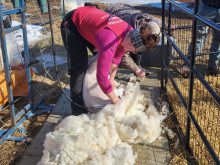A made-in-Saskatchewan biosecurity system for the horse industry has the best chance of success, says a retired hog veterinarian.
Jim Sawatsky, who raises crossbred hitch horses near Humboldt, Sask., and spent 35 years overseeing biosecurity in hog barns, said it has to be producer driven for people to believe in it.
“If you told them they had to do it, they wouldn’t do it,” he told delegates at the Saskatchewan Horse Federation annual conference in Saskatoon March 7.
Sawatsky said Saskatchewan could take a lead role in developing protocols for a biosecurity model because it represents a more typical farm model in which horses are not heavily concentrated.
Read Also

Charges laid after cattle theft
Saskatchewan RCMP lay two charges against a man after six cattle went missing.
He predicted requirements for horses will soon be similar to those already in place for hogs and cattle.
Sawatsky compared the horse industry today with the hog industry a decade or more ago. He said hog producers worked together to develop common rules and regulations.
“The producers sold it to one another,” he said, noting how meetings allow people to build on each other’s ideas. “You don’t know how much you know.”
The horse industry needs to understand the principles behind biosecurity and become proactive to reduce disease in animals, he said.
Dawn Lawrence of Horse Welfare Alliance Canada said producers must recognize that a bit or bridle can make a horse sick because it might carry disease from one horse to another.
“It’s such considerations we’ve taken for granted,” she said. “We’ve become at ease that nothing is going wrong, and we forget to do the things we need to do to be sure.”
Horses are routinely moved to shows and other farms and Lawrence said the industry has been fortunate to dodge disease. She called the recent outbreak of equine herpes “scary but managed.”
Doug Howe, chair of the federation’s horse industry committee, said the horse industry is fragmented into factions such as breeders, trainers, riders, recreation and agriculture.
He said they need to meet and share their stories to counter animal welfare activists who challenge rodeos and horse meat production in a softening marketplace.
“We have to sell it outside our circle,” he said. “People are aware of us, but many don’t understand us.”
Humane care and handling of animals from birth to death must be assured, added Lawrence.
“If an animal’s health is compromised, animal welfare is compromised.”
Her group has fielded more reports of horse neglect and abandonment since slaughter plants closed in the United States. Cross-border movement of horses has also increased dramatically into Mexico and Canada.
















